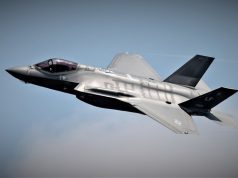The first iteration of the US Air Force’s trademark Red Flag exercise to feature F-35 Lighting IIs from the RAAF concluded at Joint Base Elmendorf-Richardson on August 27.
RF-A is a Pacific Air Forces-sponsored multinational exercise that provides a simulated combat environment through a series of large force employment training, close air support, and joint offensive counter-air exercises.
This iteration of RF-A involved participation by the Royal Australian Air Force, in addition to the multiple US military units who arrived from Kadena Air Base, Japan, and from military installations across the US.
Australia’s four newest F-35A Lightning II aircraft to roll off the Lockheed Martin production line in Texas headed straight to Alaska to participate in the exercise Red Flag 21-3. After the completion of the exercise, they will land on Australian soil as part of Exercise Lightning Ferry 21-3, bringing Australia’s fleet to 41 of 72 planned aircraft.
Other aircraft deployed by Australia for the exercise included an E-7A Wedgetail, and EA-18G Growlers.
“This exercise was a great opportunity for us to work closely with units from Australia and from all around the United States, showing our resolve to keep the Indo-Pacific region free and open,” said US Air Force Maj. Gregory Weigel, 354th Operations Group Detachment 1 assistant director of operations.
“Red Flag provides an excellent opportunity for our two countries in continuing to improve our interoperability and integration,” said RAAF Squadron Leader John Thornton, 2 Squadron Detachment commander. “Not only does this include the aircraft flying the missions, but also between all the support personnel from both countries like the intelligence and maintenance teams.”
“This integration and interoperability is essential in developing an intelligent and skilled workforce that is ready to deliver air power when called upon,” Thornton said.
RF-A occurs three to four times each year, with the majority of takeoffs from both JB Elmendorf-Richardson and Eielson Air Force Base.
“We accomplished a variety of training from aerial refueling, dirt landing zones and cargo airdrops to air-to-air combat and air-to-surface combat against a large simulated enemy force,” Weigel said.
Alaska’s strategic value for the exercise is due to its vast airspace, varied terrain and advanced range complexes, chiefly the Joint Pacific Alaska Range Complex, or JPARC. The JPARC boasts thousands of square miles of land and airspace, providing a realistic training environment that accommodates new technologies’ increased mobility, expanded capabilities and improved communications.
Approximately 1,800 US and RAAF service members flew, maintained and supported more than 80 aircraft from more than 20 units during this iteration of the exercise.
“Two Squadron is fortunate to get the opportunity to participate in a wide variety of exercises with the US Air Force,” Thornton said. “The relationships that are forged cannot be underestimated, and form part of the foundation that sees the Australia and US alliance become stronger through engagement.”
Royal Air Force F-35B aircraft completed their first Red Flag appearance in early 2020.



























